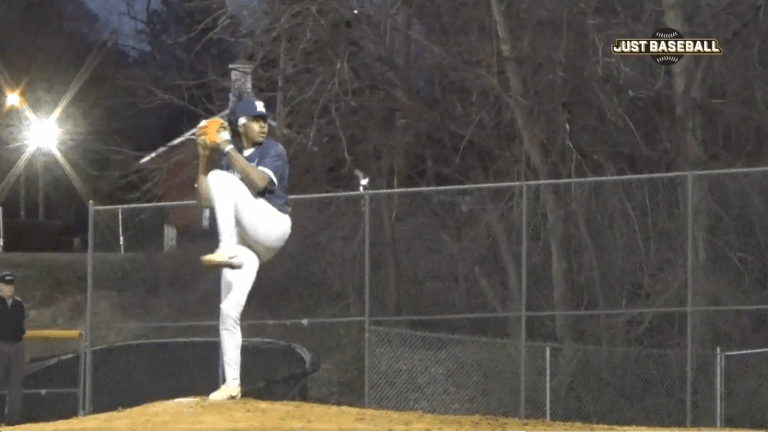Meet CJ Gray: A North Carolina Flamethrower
Gray's athleticism, electric arm speed, and fastball provide a solid mold of clay for a development team to work with.

“Give me fuel, give me fire, give me that which I desire, ooh”
*James Hetfield downpicking intensifies*
Oh wait, this isn’t a concert, I got ahead of myself. But, I couldn’t pass up introducing a hard-throwing pitcher with those lyrics.
Before the season started, I promised myself I would see more high school prospects. Over the past few years, my coverage has lacked this, and it has been tough to make it happen with school and work. Now that I have more freedom, it is time to make it happen.
While there’s quite a bit of talent around the state, I was deadset on a certain arm from Kannapolis.
Enter CJ Gray.
He was QB1 on Friday nights in the fall, and now, he’s got scouts flocking to see his Wednesday night starts. After touching 96 MPH last summer with the South Charlotte Panthers, Gray is a hot commodity amongst North Carolina scouts and will have some tough decisions to make in the near future.
While the velocity itself is impressive, what else makes him a potential draft arm? That’s what I’m here to explain, as Gray’s athleticism, electric arm speed, and fastball provide a solid mold of clay for a development team to work with. It’s time to dive into what I saw last week and why I’m bullish on the profile.
Gray is listed at 6’1, 193 pounds, and to be honest, that might be underselling the specimen itself. At first glance, there look to be solid muscle gains in the lower half, though a good bit of projection remains to his long, lanky frame.
The biggest asset in his profile is the pure athleticism on display. He’s a very fluid mover down the bump, oozing athleticism with drop and drive to his mechanics. The repeatability of his mechanics is inconsistent, which displays the rawness of his profile, but that will get better as time goes on and he gets stronger.
To pair with the athleticism, Gray possesses explosive arm speed and whippiness from a three-quarters arm slot. These are the kind of traits you see in arms that touch triple digits, and many expect that Gray will be capable of tickling the 100 MPH barrier in due time.
Another trait that can be seen on film is the vertical approach angle (VAA) that he’s able to generate to the plate. His release height plays a big factor into the angle, which helps the heater play better, especially as Gray learns to maintain consistent velocity and release points on the pitch.
Here's open-side mechanics of Gray, including slow-mo.
— Tyler Jennings (@TylerJennings24) February 27, 2025
Lots to rein in, but athleticism shines. Fun mold of clay to work with that has solid foundation laid with FB. https://t.co/c7QvEyTo9z pic.twitter.com/1cu1L9S6eJ
Now, let’s talk about the velocity.
While Gray was on a pitch count, he did a solid job of maintaining his velocity throughout his abbreviated start. Gray touched 97 MPH three times during the first inning, sitting 93-96 throughout the inning and adding more velocity with more pitches.
This trend continued in the second and third innings, though at a slightly lower tick. Gray sat 92-95 MPH in the second and 91-94 MPH in the third, topping out at 96 MPH and 95 MPH, respectively. His final bolt was 95 MPH to strike out his seventh batter of the outing.
With the lowered arm slot, Gray generated more running life and some sink on his fastball. The “bowling ball” nature of his heater gave him the ability to tie up the hands of right-handed hitters, though he’s still working on consistently pitching inside. His old arm slot allowed him to generate more backspin on the baseball, which helped him find good carry on his heater.
All in all, the foundation for a potentially plus fastball has been laid down.
RHP CJ Gray (@cj97823343) is a name to know in this class.
— Tyler Jennings (@TylerJennings24) February 27, 2025
Loud arm talent with explosive arm speed and life to the heater. Sat 93-96 T97 in the first before settling in at 91-95 T96 in second and third. Great athlete, CMD is a WIP.
Flashed soft breaker and CH in warm-ups. pic.twitter.com/QHcFaDx3he
Gray’s command is a work in progress. Given the aforementioned struggles to repeat his mechanics consistently, Gray was unable to find a consistent release point at times, leading to a walk and three HBPs on the night. As he grows stronger, he’ll become more in sync with his mechanics, and this issue should be improved upon, though time will tell on that front.
Gray was predominantly fastball-heavy in his gameplan, though he dabbled with a softer breaking ball and fading change-up in warm-ups. The breaking ball has two-plane tilt, but the command and bite are lacking at this moment. The spin traits aren’t eye-opening, nor does he throw it hard, but fixing breaking ball feel is easier to do than changing fastball shapes.
The change-up was thrown in the mid-80s with good fading life, though it was not thrown in the game. Getting more in-game reps and throwing it with conviction will be key developing points here for Gray.
The NC State commit will have plenty of decisions to make in the near future, but there’s promise in this profile. The fastball foundation is a key component in my scouting analysis, and Gray’s strength is hard to ignore here, as he could very well be hitting triple digits in due time.
The command should iron itself out as he gets stronger and becomes more in sync with his body, plus his secondaries should benefit from time in a major league development program.
For me, Gray profiles near the beginning of the second day of the draft in the 4th-5th round range. The arm talent is legitimate.
